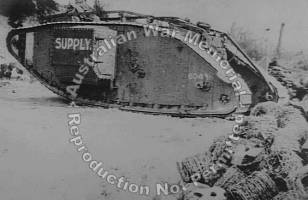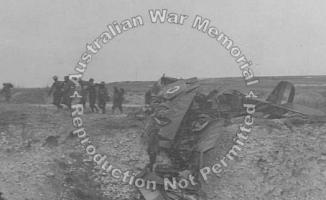
Peronne, 27 March 1919. A Mark V (male) Battle Tank, a remnant on the battlefield. AWM E04445© |
By watching the new tanks, Monash and
Rawlinson were convinced that this new weapon could reduce the losses and
increase the chance for the attack on Le Hamel. So they asked for the involvement
of tanks. Monash got sixty tanks in five companies under General A. Courage
command (Tank Corps, 5th Brigade). In his opinion, tanks would precede
the infantry and would take the place of the artillery barrage which normally
suppressed the fire of the German machine guns. It was not the point of
view of the Australian infantry officers. They knew from experience that
the troops could advance safely under the close protection of the artillery
barrage but that it was a great risk to rely on the tanks. So, Monash insisted
in that the tanks would follow the first infantry wave and obey the orders
of the infantry officers on the ground – calling them forward when there
was sufficient light to deal with any stubborn German strong points that
survived the Artillery barrage.
|

Villers-Bretonneux. August 1918. Supply tank en route to the lines. Note the rolls of barbed wire in the right foreground. AWM C04889© |
In addition to the assault tanks, they
were four carrier tanks to supply the advancing troops. Each of those tanks
could quarry 134 barbwire coils, 450 piquets, 45 irons sheets, 50 waters
cans, 150 mortars bombs, 10.000 rounds and 20 grenades boxes. Entirely,
these four carriers would do the job of almost 1.200 men and in less time
with little risk of casualties.
|



